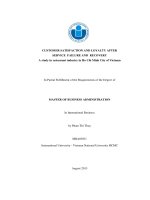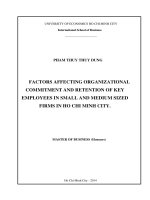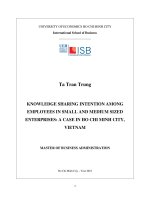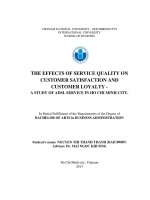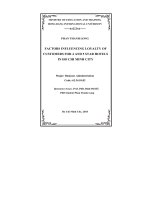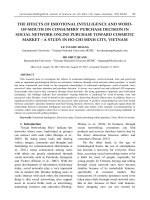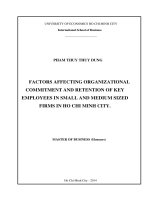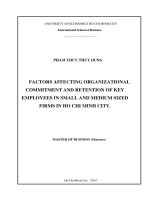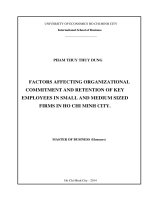Customer satisfaction and loyalty after service failure and recovery a study in restaurant industry in ho chi minh city of vietnam
Bạn đang xem bản rút gọn của tài liệu. Xem và tải ngay bản đầy đủ của tài liệu tại đây (490.66 KB, 87 trang )
CUSTOMER SATISFACTION AND LOYALTY AFTER
SERVICE FAILURE AND RECOVERY
A study in restaurant industry in Ho Chi Minh City of Vietnam
In Partial Fulfillment of the Requirements of the Degree of
MASTER OF BUSINESS ADMINISTRATION
In International Business
by Pham Thi Thuy
MBA03031
International University - Vietnam National University HCMC
August 2013
CUSTOMER SATISFACTION AND LOYALTY AFTER
SERVICE FAILURE AND RECOVERY
A study in restaurant industry in Ho Chi Minh City of Vietnam
In Partial Fulfillment of the Requirements of the Degree of
MASTER OF BUSINESS ADMINISTRATION
In International Business
by
Ms. Pham Thi Thuy
ID: MBA03031
International University - Vietnam National University HCMC
August 2013
Under the guidance and approval of the committee, and approved by all its members,
this thesis has been accepted in partial fulfillment of the requirements for the degree.
Approved:
---------------------------------------------Chairperson
---------------------------------------Advisor
---------------------------------------------Committee member
---------------------------------------Committee member
---------------------------------------------Committee member
---------------------------------------Committee member
ACKNOWLEDGEMENT
To complete this thesis, I have been benefited from the great deal of help from many
people. I would like to take this opportunity to sincerely thank them for all what they
have done for me.
Fist of all, I would like to express my gratitude to my advisor, Associate Professor Le
Nguyen Hau, who has given me guidance, advice, feedback and supervision during
the course of my research. Only thank to his help my research was developed,
executed and completed.
I also do not forget to thank the data collection team who have assisted me in
collecting data in such a limited time.
Finally, I would like to thank you my family and friends for the continuous support
and encouragement given to me.
Plagiarism Statements
I would like to declare that, apart from the acknowledged references, this
thesis either does not use language, ideas, or other original material from anyone; or
has not been previously submitted to any other educational and research programs or
institutions. I fully understand that any writings in this thesis contradicted to the above
statement will automatically lead to the rejection from the MBA program at the
International University – Vietnam National University Hochiminh City.
Copyright Statement
This copy of the thesis has been supplied on condition that anyone who
consults it is understood to recognize that its copyright rests with its author and that
no quotation from the thesis and no information derived from it may be published
without the author’s prior consent.
© Pham Thi Thuy / MBA03031/2013
Table of Contents
CHAPTER 1 - INTRODUCTION ............................................................................. 1
1.1
Research background ................................................................................. 1
1.2
Problem statement...................................................................................... 2
1.3
Research objectives.................................................................................... 3
1.4
Contribution of the research ....................................................................... 3
1.5
Research structure...................................................................................... 4
CHAPTER 2 – THEORY FRAMEWORK AND HYPOTHESES ............................. 5
2.1
Theory framework ..................................................................................... 5
2.1.1
Service failure and recovery attributes .................................................. 5
2.1.2
Equity theory........................................................................................ 7
2.1.3
Justice theory and three justice dimensions........................................... 7
2.1.4
Justice evaluation ............................................................................... 10
2.1.5
Justice dimensions and customer satisfaction...................................... 10
2.1.6
Customer satisfaction and loyalty ....................................................... 11
2.1.7
Social Status Orientation and Customer Satisfaction........................... 11
2.2
Research model and hypotheses ............................................................... 12
CHAPTER 3- RESEARCH METHOD................................................................... 14
3.1
Research design ....................................................................................... 14
3.2
Research process...................................................................................... 15
3.3
Data collection......................................................................................... 15
3.4
Data analysis............................................................................................ 20
3.4.1
Coding data ........................................................................................ 20
3.4.2
Descriptive statistics.......................................................................... 21
3.4.3
Reliability test (Cronbach’s Alpha)..................................................... 21
3.4.4
Validity test........................................................................................ 22
3.4.5
Regression analysis ............................................................................ 22
3.4.6
Test effect of moderating variables..................................................... 23
3.4.7
One-way Anova ................................................................................. 23
CHAPTER 4 – RESEARCH RESULTS .................................................................. 24
4.1
Response rate........................................................................................... 24
4.2
Demographic profile ................................................................................ 24
4.3
Descriptive statistics ................................................................................ 27
4.3.1
Distributive justice attribute................................................................ 28
4.3.2
Procedural justice attribute ................................................................. 28
4.3.3
Interactional justice attribute............................................................... 29
4.3.4
Customer satisfaction ......................................................................... 30
4.3.5
Customer loyalty ................................................................................ 30
4.3.6
Modern Status Orientation (MSO) ...................................................... 31
4.4
Result of reliability test ............................................................................ 31
4.4.1
Cronbach’s alpha of three justice variables ......................................... 31
4.4.2
Cronbach’s anpha of customer satisfaction ......................................... 33
4.4.3
Cronbach’s alpha of customer loyalty................................................. 34
4.4.4
Cronbach’s alpha of moderating variable- modern status orientation .. 34
4.5
Result of validity test ............................................................................... 35
4.5.1
Exploratory Factor Analysis (EFA) of independent variables............. 35
4.5.2
EFA of dependent variable – customer satisfaction............................. 38
4.5.3
EFA of dependent variable – customer loyalty.................................... 39
4.5.4
EFA of morderating variable- modern status orientation..................... 41
4.5.5
Rename factors................................................................................... 42
4.5.6
Restate model..................................................................................... 44
The models and hypothesis were restated as followings: ................................. 44
4.6
Regression analysis and hypothesis testing.............................................. 44
4.6.1
Correlation testing .............................................................................. 44
4.6.2
Regression analysis ............................................................................ 45
4.6.3
Hypothesis testing .............................................................................. 47
4.6.4
Test effect of moderating variables..................................................... 48
4.6.5
Analysis of Variance (ANOVA)......................................................... 52
CHAPTER 5 – DISCUSSION AND IMPLICATIONS............................................ 53
5.1
Effect of outcome justice evaluation on customer satisfaction .................. 53
5.2
Effect of interactional justice on customer satisfaction ............................. 54
5.3
Satisfaction and loyalty ............................................................................ 55
CHAPTER 6- CONCLUSION AND RECOMMENDATION ................................. 57
6.1
Conclusion............................................................................................... 57
6.2
Recommendation ..................................................................................... 58
6.3
Limitation and suggestion ........................................................................ 59
REFERENCE .......................................................................................................... 61
APENDIX ............................................................................................................... 64
Apendix 1: Survey Questionnaire (Vietnamese version) ...................................... 64
Apendix 2: Survey Questionnaire (English version)............................................. 69
Apendix 3: Data coding....................................................................................... 73
List of Tables
Table 2-1 : Definition of justice elements and representative researchs…………...……..9
Table 3-1: Summary of measurement scale……………………...………………………18
Table 3-2 : Summary of coding variables………………………………………………..21
Table 4-1: Summary of demographic profile…………………………………………….25
Table 4-2: Summary of demographic profile (continued 1)……………………………..27
Table 4-3: Summary of demographic profile (continued 2 )………………………….....28
Table 4-4 : Summary of descriptive statistics of distributive justice…………………….29
Table 4-5 : Summary of descriptive statistics of procedural justice……………………..29
Table 4-6 : Summary of descriptive statistics of interactional justice…………………...30
Table 4-7 : Summary of descriptive statistics of customer satisfaction…………………31
Table 4-8 : Summary of descriptive statistics of customer loyalty………………………31
Table 4-9 : Summary of descriptive statistics of modern status orientation……………..32
Table 4-10 : Reliability coefficient of distributive justice measurement scale…………..33
Table 4-11: Reliability coefficient of procedural justice measurement scale……………33
Table 4-12: Reliability coefficient of interactional justice measurement scale………….34
Table 4-13 : Reliability coefficient of customer satisfaction measurement scale…...…..35
Table 4-14: Reliability coefficient of customer loyalty measurement scale……………..35
Table 4-15 : Reliability coefficient of modern status orientation measurement scale......36
Table 4-16: KMO and Bartlett's Test independent variable)…………… …………….36
Table 4-17: Total Variance Explained (independent variables)…...…………………….37
Table 4-18: Rotated component matrix (independent variables)………………………...38
Table 4-19: KMO and Bartlett's Test (Customer satisfaction)………...………………...39
Table 4-20: Total variance explained (Customer satisfaction)…………………………..39
Table 4-21: Component matrix…………………………………………………………..40
Table 4-22: KMO and Bartlett's Test (Customer loyalty)……………………...………..40
Table 4-23: Total variance explained (Customer loyalty)……………………………….41
Table 4-24: Component matrix (Customer loyalty)……………………………………...41
Table 4-25: KMO and Bartlett's Test (Modern status orientation)………………………42
Table 4-26: Total variance explained (Modern status orientation)……………………...42
Table 4-27: Component matrix (Modern status orientation)…………………………….42
Table 4-28: Summary of renamed factors after EFA…………………………………....44
Table 4-29: Pearson correlations………………...………………………………………46
Table 4-30: Model summary……………………………………………………………..46
Table 4-31: Regression – coefficient of dependent variables……………………………47
Table 4-32: Model summary……………………………………………………………..47
Table 4-33: Regression – coefficient of dependent variables……………………………48
Table 4-34: Summary result of hypotheses test………………………………………… 48
Table 4-35: Summary of regression analyses (by modern status orientation)…………...49
Table 4-36: Summary of regression analyses (by Gender)………………………………50
Table 4-37: Summary of regression analyses (by Age)………………………………….50
Table 4-38: Summary of regression analyses (by Service failure type)………………... 51
Table 4-39: Summary of regression analyses (by Frequency) …………………………..52
Table 4-40: Summary of regression analyses (by Income)…………………...…………52
Table 4-41: Test of Homogeneity of Variance…………………………………………..53
Table 4-42: Result of ANOVA test……………………………………………………...53
List of Figures
Figure 2-1: Research model…………………………………………………………13
Figure 3-1: Research process………………………………………………………..15
Figure 4-1: Revised research model…………………………...……………………45
Abstract
This research was conducted to examine the evaluation of customers towards result of
service recovery of organizations. In this paper the three justice dimensions was
employed to explain the customer satisfaction after service failure and recovery in
restaurant setting in Ho Chi Minh City fo Vietnam.
Convenient sampling method was used to collect data by means of a survey. SPSS
software version 20 was used to analyse collected data set. The measurement scales
were adopted and adjusted from previous research. Exploratory Factor Analysis was
applied to refine measurement scale and reduce factors. Research model and
hypotheses were tested using regression analysis.
The result of data analysis provided empirical evidence that justice evaluation has
positive effect on customer satisfaction after service failure and recovery. The result
also confirmed that customer satisfaction and their loyalty had strong correlation.
Implications for the organizations in restaurant industry is that in order to better
satisfy customers and retain their loyalty besides improving product qualtity, service
quality and price service providers should understand the perception of justice
evaluation and have effective strategy to recover service failure when it occurs.
Keywords: service failure, service recovery, customer satisfaction, loyalty.
CHAPTER 1 – INTRODUCTION
1.1
Research background
Challenge facing most of organizations now is how to develop and implement
strategies aim at satisfying customers, who always have higher demand on better
service quality, and retaining their loyalty. Organizations are nowadays copping with
high level of competitiveness due to current trend of economic globalization and
integration of countries around the world (Yeung 2006). In a competitive market
service providers, especially those organizations in the industries that have higher
service failure rate such as restaurant, are required to always maintain good quality
product and high service level.
Many companies consider investment in complaint handling as a way to increase their
overall service quality as well as increase customer commitment and build up
customer loyalty. However they are not sure how to resolve service failure effectively
and how to measure customer satisfaction after service recovery (Tax, Brown and
Chandrashekaran 1998)
The opinion that companies can increase profit by nearly 100 percent by retaining just
5 percent more of their customers (Reichheld and Sasser 1990) makes service failure
and recovery has even more important to organizations, and service failure then
becomes one of key factor that directly affect customer switching behavior (Roos
1999).
In their reasearch Fisk, Brown, and Bitner (1993) also argued that due to nature of
service it is not possible for companies to provide 100% error-free services. Therefore
putting effots in resolving customer complaints effectively play an important role in
winning back customer trust and their commitment. Consequently, the way how to
manage service failure recovery and to know consumer responses to the recovery
process are increasingly seen as factors that may separate the more successful
organizations from the others.
While organizations could be aware of the impact that organization responses to
service failure had on customers’ intention of repurchase and their loyalty, they were
less sure which aspect of the service failure recovery effort were driving customer
satisfaction and their loyalty more than the others.
1.2
Problem statement
In recent years the restaurant industry in Vietnam especially in Ho Chi Minh City has
been developing quickly and people tend to eat out in restaurants more often than to
cook at home. This trend makes the restaurant business more attractive to investors
but since Vietnam was opening to globalization to catch up with fast development of
the world customers started to require up-to-international standard services. The
competition in restaurant industry in Vietnam therefore getting tense than ever before
when customers now have more choices than they had in the past. In order to meet
higher expectation and demand from customers
it is vital for organizations to
continuously improve their competitive advantage through their best service quality.
The some restaurants, especially big and foreign brands, in Ho Chi Minh City are
always rated superior than other local restaurants in term of service quality and
complaint handling. This could be easily seen in the multinational fastfood restaurant
chains where service quality is high and standardized. These restaurants make the
customer complaint procedure easy and flexible to their customers and they also take
initiative to recover service failure. This is going to be a big challenge for small and
medium local restaurants who would like to compete to gain market share or at least
to retain their existing customers.
In addition, not so many Vietnamese customer have habbit to lodge in the complaint,
when service failure occur they choose to ignore because either complaint processes
too complicated or customers do not think that service providers is going to fix the
problems for them. Even though some restaurants are very proactive by sending out
the satisfaction survey questionaires, customers are still not familiar or not interested
in giving restaurants the feedback. Such channels as email, hotline, facebook, website
are also not really effective ways for restaurants to get to know the customer
evaluation towards their service quality and their service recovery performance.
Therefore how to understand current state of how (at what level) customers rate their
service failure recovery result for them to take necessary corrective and preventive
actions becomes essential for all restaurants.
Restaurant is a high interaction or “high contact service” industry which is associated
with its high service failure rate as nature of the industry. The bad impact of service
failure could be huge because unsatisfied customers who experienced service failure
may not go back the restaurant again, they may also talk unconstructive about the
restaurant to others and start to look for other restaurants as replacement. Therefore
besides trying to offer the diners the best service in the first place it is more important
for organizations in this industry to enhance customer satisfaction and increase loyalty
after service failures to increase market share and profit at the end.
1.3
Research objectives
The main purpose of this thesis is to investigate the evaluation of customers toward
service recovery performance of the organizations. The study also examined the
impact of customer evaluation on future relationship which is reflected through the
loyalty level customers have to organizations after service encounter in the case of
restaurant industry in Ho Chi Minh City of Vietnam. The specific objectives of this
research therefore are as followings :
- To identify the relative importance of individual justice attributes in explaining the
customer satisfaction after service failure and recovery.
-
To recommend alternatives to effectively recover service failure to improve
customer satisfaction and customer loyalty.
The main questions that this research focuses to explore are :
1. Currently how do customers evaluate the service failure recovery of
restaurants in Ho Chi Minh City ?
2. How does the customer satisfaction after service failure and recovery impact
the loyalty level of customers with restaurants in Ho Chi Minh City ?
1.4
Contribution of the research
The measurement scale and collected data analysis gives management in restaurant
industry an idea of how customers evaluate their service recovery performance base
on perception of different justices.
The findings of this research helps organizations in retaurant industry understand the
effect of justice evaluation of customer on their satisfaction after revice failure and
recovery. The study also recommends alternatives to improve customer satisfaction
and loyalty after service failure and recovery.
1.5
Research structure
This research comprises 6 chapters namely Introduction, Theory Framework and
Hypotheses, Research Method, Research Results, Discussion and Implication,
Conclusion and Recommendation.
Chapter 1 (Introduction) introduced the research background, define research
problem and research objectives to confirm the necessity for this research.
Chapter 2 (Theory framework and hypotheses) presented theoretical background for
researched problem; the related theories and previous researches that were used to
support data analysis, support the interpretation and discussion of research findings
later.
Chaper 3 (Reseach method) presented the source of information, data collection and
data analysis method as well as the plan for data analysis.
Chapter 4 (Research results) analyzed the collected data and inteprete the research
result.
Chapter 5 (Discussion and implication) discussed the implications of the research
results presented in previous chapter in the light of the literature review.
Chapter 6 (Conclusion and recommendation) proposed some conclusions and as a
result of finding and significance of study, researcher recommended some solution to
solve the problem mentioned.
CHAPTER 2 – THEORY FRAMEWORK AND HYPOTHESES
2.1
Theory framework
2.1.1 Service failure and recovery attributes
According to Polaris Marketing Research, a service failure is defined as a service
performance that fails to meet a customer expectations. Service failures could be
devided into two main types, which are outcome and processs failure and being
mentioned in many service marketing literatures (Bitner, Booms, and Tetreault 1990;
Keaveney 1995; Mohr and Bitner 1995). The outcome aspect of service failure
involves what customers actually receive from the service, whereas the process
dimension is more about how customers receive the service or how the service is
delivered to customers (Gronroos 1988, Parasuraman, Zeithaml, and Berry 1985). In
other words, in an outcome failure, organization fail to fulfill basic service need or fail
to perform core service while for process failure, the delivery of core service is
deficient in some way.
Service recovery refers to actions an organization takes in response to service failure
(Gronroos 1988). When a service failure occurs, service providers try to fix the
problem by compensating for the losses that service failures caused to their customers
or taking necessary actions to prevent the service failure happen again in future. The
service failure recovery performance of organization could be in following forms:
Compenstion: Social exchange theory emphasizes role of distributive justice because
it relates to the allocation of costs and benefits in achieving equitable exchange
relationships (Deutsch 1975, 1985). In term of service recovery, distributive justice
perceptions involve the allocation of compensation (in form of discount, refunds,
coupons and others) by the organization in response to the inequity that service failure
caused. Walster, Berscheid, and Walster (1973) have shown that compensation is a
strategy for restoring equity in an exchange relationship when one party has been
harmed by the other. Tax, Brown, and Chandrashekara (1998) use content analysis of
qualitative evaluation of service complaint experiences to show that compensation is
the most important recovery dimension associated with customers’ perceptions of
distributive justice. Therefore it was suggested that higher level of compensation
should result in higher distributive justice evaluation.
Response speed: The issues of timing, responsiveness and customer waiting have
been addressed in the complaint and service encounter literatures ( Bitner, Booms,
and Tetreault 1990; Clemmer and Scheneider 1993, 1996; Kelly, Hoffman, and Davis
1993; Maister 1985; Parasuraman, Zeithaml, and Berry 1985). A quick recovery
response to service failure will enhance customer evaluations (Clark, Kaminski, and
Rink 1992; Heskett, and Sasser 1990). Specially the speed with which problems and
complaints are handled has been identified as an important dimension of procedural
justice (Blodget, Hill and Tax Chandrashekaran 1998). Therefore the longer it takes
service firms to recover the service failure, the lower customer evaluate their
procedural justice.
Apology: In social exchange and equity theories, an apology is viewed as a valuable
reward in an exchange relationship (Walster, Berscheid, and Walster 1973). An
apology from a service provider could be viewed as the politeness, courtesy, concern,
effort and empathy to customers who have experienced a service failure. An apology
can help to enhances customer evaluation (Hart, Heskett, and Sasser 1990). An
apology also show quality of interpersonal treatment and communication during
service recovery process and has been associated with customers’ perception of
interactional justice (Blodgett, Hill, and Tax 1997)
Recovery Initiation: Service recovery consists of broader course of activities than
complaint handling because it includes situations where service failure occurs but no
complaint is recorded. An absence of complaint in service failure is because
customers sometimes are unable or not willing to complain or in some cases the
complaint is not necessary because it has been recognized and acknowledged by the
service provider. Studies showed that 70% to 95% of dissatisfied customers do not
bother to complain and several researchers have suggested that proactive service
recovery effort will enhance customers evaluation of the service provider ( Berry
1995; Johnston 1995; Kelley, Hoffman, and David 1993). Therefore it is good for
organizations to always initiate their service recovery effort rather than to wait until
customer lodge an official complaint then organization reactively resolve it. When
organization initiate a recovery, customer perception of interactional justice should be
enhanced, because customers likely to view a proactive effort as an act of courtesy, an
implication of honesty and a show of empathic understanding and respect.
The service marketing literatures also provides information that different type of
failure causes different categories of loss to customers therefore service failure type is
expected to impact on customer satisfaction judgements toward service recovery.
Therefore, it is expected that three types of service failures, namely staff attitude, staff
skill and service procedure have moderating effect on relationship between justice
evaluation and customer satisfaction.
2.1.2
Equity theory
Equity theory has been applied in customer satisfaction research very early. The
equity is about fairness, rightness, or deservedness judgement that we make in
reference to what others receive (Oliver 1997, p.194). This theory suggests that in an
exchange if customers feel inequitily treated and their input to exchange is not tally
with output of the exchange, then there will be not a satisfaction (Goodwin and Ross
1992, Oliver 1997). This theory also suggests that customers are concerned not only
with the perceived fairness of the outcome they receive, but also with the perceived
fairness of the process used to deliver the outcome (Conlon and Murray 1996). These
two concerns were being referred to as distributive and procedural justice,
respectively. Some studies also separate out the inter-personal aspect of the
procedural justice, referred to as interactional justice, which emphasized the manner
in which the process is executed and information is communicated to the customer by
the service provider (Seiders and Berry 1998)
The equity theory was found very powerful in explaining recovery satisfaction (Smith
et al.1999; Tax et al.1998). Assuming that customers often perceive an inequity
following a service failure, they then need a justice and they are more likely to engage
in equity evaluation (Hoffman and Kelly 2000). It is also argued that because
consumers confront a specific service scenarios, the equity, which is based on the
comparison between self and others, is more obvious in service rather than product
failure situations (Goodwin and Ross 1989; Seiders and Berry 1998).
2.1.3 Justice theory and three justice dimensions
An allocation decision has been defined by Bies and Moag (1986) as “ a sequence of
events in which a procedure generates a process of interaction and decision making
through which an outcome is allocated to someone. This is clarified by Austin
(1979,p.24) that “Justice pertains not merely to outcome distribution but also to how
the distribution arrived at and the manner by which it is implemented”. Therefore,
justice involves not only the outcome but also the procedure of making the decisions
lead to the outcome.
A three dimensional view of the concept includes :
(a) Distributive justice: dealing with decision outcomes. It is evaluated by one of the
three decision rules; equality, equity or need (Deutsch 1975).
(b) Procedural justice: dealing with decision making procedure. Procedural justice is
concerned with the fairness of the procedures used in making decision (Folger and
Greenberg 1985). It is the extent to which procedures used to determine a distribution
of outcomes (Goodwin and Ross 1990) as it was believed that the way decisions are
reached is just as important as the decision itself.
(c) Interactional justice: dealing with interpersonal behavior in enactment of
procedures and delivery of outcomes. It relates to the interpersonal communications in
the decision making process. It emphasizes the style with which a decision is
implemented. The presence of a policy or rule does not mean that the policy is fairly
applied. Therefore a distinction must be made between a policy and a guideline and
how the policy is implemented (Vermunt, Van der Kloot, and Van der Meer 1993).
Interactional justice also conveys a common courtesy, politeness, respect, empathy
and willingness to listen.
The justice theory explains how people judge and response to an outcome, procedure
and manner to implement procedure base on their perception of justice .
Table 2-1 : Definition of justice elements and representative researchs
(Source : Journal of Markeing Vol.62 April 1998, P. 63)
Concept
Distributive
Justice
Equity
Equality
Need
Prodedural
Justice
Process
control
Definition
Dependent variables
Previous research
Provision of outcomes Satisfaction, repurchase Goodwin and Ross
proportional to inputs to an intention, word of (1992), Oliver and
exchange.
mouth.
Desarbo (1988), Oliver
and Swan (1989)
Equal outcomes regardless Satisfaction,
social Greenberg(1990)
of contribution to an harmony
Deutsch(1985)
exchange.
Outcomes
base
on Satisfaction
Deutsch (1985)
requirements regardless of
contributions
Decision
control
Extend to which a person is Satisfaction
free to accept or reject a
decision outcomes
Goodwin and Ross(1992),
Kanfer et al.(1987), Lind
and Tyler (1988).
Brett (1986), Heide and
John(1992). Bitner,
Booms, and Tetreault
(1990)
Accessibility
Ease of engaging a process
Satisfaction
Bowen and Lawler(1995)
Timing/speed
Perceived amount of time
taken to complete a
procedure
Anger, uncertainty,
Satisfaction, service
quality
Fisk and Coney (1982)
Maister (1985)
Taylor (1994)
Flexibility
Adaptability of procedures
to
reflect
individual
circumstances
Market orientation,
satisfaction
Bitner, Booms, and
Tetreault (1990). Narver
and Slater (1990)
Provision of reason for
failure
Attributions for failure,
satisfaction, fairness
Honesty
Perceived
veracity
information provided
Satisfaction (complaint
handling)
Bies and Shapiro(1987)
Bitner, Booms, and
Tetreault (1990)
Goodwin and Ross(1989)
Politeness
Well-mannered, courteous
behavior
Complaint evaluation,
repurchase intention,
satisfaction
Effort
Amount of positive energy
put into resolving a
problem
Provision
of
caring,
individual attention
Anger, satisfaction,
trust
Interactional
Justice
Explaination/
causal account
Empathy
Freedom to communicate Satisfaction,
views on a decision process commitment
of
Service quality,
satisfaction
Blodgett, Hill and
Tax(1997), Clemmer
(1988), Goodwin and
Ross(1989)
Folkes (1984), Mohr and
Bitner (1995)
Parasuraman, Zeithaml,
and Berry (1988)
2.1.4 Justice evaluation
Service failure and recovery can be seen as an exchange relationship in which
customers experience a loss due to service failure and the organizations attempt to
provide a gain, in the form of recovery effort to compensate for the customer’s loss
(Homans 1961; Walster, Berscheid and Walster 1973; Watster and Berscheid 1978).
Service failure and recovery can be considered mixed exchanges with both utilitarian
and symbolic dimensions. Utilitarian exchange envolves economic resources such as
money, goods or time, whereas symbolic exchange involves psychological or social
resources, such as status, esteem, or empathy (Bagozzi 1975).
Service failures can result in loss of economic or social resouces for customers. Hence
organizations may attempt to recover it by offering customers in form of
compensation, response speed, apology or initiation. Customer then will evaluate the
service failure and recovery by comparing the amount of resource lost and gained
during the exchange.
2.1.5 Justice dimensions and customer satisfaction
Customers evaluate service failure recovery performance in terms of the outcome or
benefits they receive as a result of service failure encounter, the procedures
organization used to arrive at the outcomes as well as the nature of the interpersonal
treatment and communication during the process (Clemmer and Schneider 1996).
Social exchange theorists have also identified three dimensions of perceived justice
(distributive justice, procedural justice, interactional justice) that influence how
people evaluate the exchanges.
Service failure and recovery is viewed as a series of actions in which a service failure
generates a procedure that will create economic and social interaction between
customer and service provider. Therefore it is predicted that customer satisfaction
with service failure recovery will be influenced by customer perception of all three
dimensions of justice.
H1: There is a positive relationship between distributive justice and customer
satisfaction with service failure recovery
H2: There is a positive relationship between procedural justice and customer
satisfaction with service failure recovery
H3: There is a positive relationship between interactional justice and customer
satisfaction with service failure recovery
2.1.6
Customer satisfaction and loyalty
Service failure recovery satisfaction refers to the degree to which the customer
perceives the company’s service failure recovery performance as meeting or
exceeding his or her expections (e.g., Gilly and Gerb 1982; McCollough, Berry, and
Yadaw 2000). Overall customer satisfaction after the service encounter refers to the
degree to which the customer perceives the company’s general performance in a
business relationship as meeting or exceeding his or her expectation (eg., Anderson
and Sullivan 1993). This type of satisfaction is cumulative in nature, whereas service
recovery satisfaction reflects a form of transaction-specific satisfaction (e.g., Bolton
and Drew 1991).
Customer loyalty refers to a strong favourable attitude towards a particular brand and
also lead to repeat purchase of the same brand (Day, 1969). Customer loyalty after
the service failure recovery refers to the degree to which a customer has continued
relationship with a company after the service failure recovery and the degree to which
he or she intends to do so in the future.
H4: There is a positive impact of overall customer satisfaction after service
failure recovery on customer loyalty.
2.1.7 Social Status Orientation and Customer Satisfaction
In their study Zeithaml and Bitner (2000) concluded that customer satisfaction is
influenced not only by product, service quality and price but also by situation factors and
personal factors. Hoyer and MacInnis (2001) also shared the same idea that
satisfaction can be associated with feelings, happiness, relief, excitement, and delight.
Wilson et al. (2008) found the same result that satisfaction generally is broader than
Price, Service and Product, these broader components that affect satisfaction are
situation and personal (Wilson et al., 2008).
In their paper about status orientation and customer choice of foreign products
Tambyah, Nguyen, and Jung (2009) developed and tested a consumer status
orientation scale in Vietnam. The status orientation was defined as a construct
focusing on consumer belief that obtaining status symbols could help them have their
social standing. The two sub-constructs of status orientation were proposed by these
authors are TSO and MSO. TSO stands for Traditional Status Orientation which
refers to consumers’ orientation toward traditional status symbols while MSO is
Modern Status Orientation which is more about modern status symbols.
The research found that high MSO consumers are particular demographic in Vietnam
who are younger and more educated. The study result explained why those
individuals may be strongly influenced by mordern values. Further, high MSO
consumers more receptive to new things and have more chances at international
experience, thus they’re more likely to influenced by modern style. The findings of
the study also confirmed that high MSO consumers tend to choose foreign products
while those with low MSO will buy domestic products.
In addition, low social status oritentation consumers could easily enjoy their happy
life without placing importance on material value. As suggested by the findings from
Tambyah, Nguyen and Jung (2009) low MSO consumers consider the care for benefit
of the others than themselves, the importance of living a simple and clean life,
regardless of wealth. Thefore being rich does not convey high status or display their
position in life.
From above discussed points, it is predicted that customers with different level of
social status orientation may access service recovery performance of organization not
in the same way, the Modern Status Orientation was then suggested to have
moderating impact on relationship between justice evaluation and customer
satisfaction after service failure recovery. Hence the hypothesis was formed as
followings:
H5: Modern Status Orientation has moderating effect on relationship between
justice evaluation and customer satisfaciton
2.2
Research model and hypotheses
The research model is presented in Figure 1 below. This model consists of three
constructs which are justice dimension, customer satisfaction and customer loyalty.
The justice dimension has a three sub-justice dimensions namely distributive justice,
procedure justice and interactional justice.
Figure 2-1: Research model
Status Orientation
Distributive justice
Procedural justice
Satisfaction after
service failure and
recovery
Customer loyalty
Interactional justice
H1: There is a positive relationship between distributive justice and customer
satisfaction after service failure and recovery
H2: There is a positive relationship between procedural justice and customer
satisfaction after service failure and recovery
H3: There is a positive relationship between interactional justice and customer
satisfaction after service failure and recovery
H4: There is a positive impact of overall customer satisfaction after service failure
and recovery on customer loyalty.
H5: Modern Status Orientation has moderating effect on relationship between
justice evaluation and customer satisfaction.
